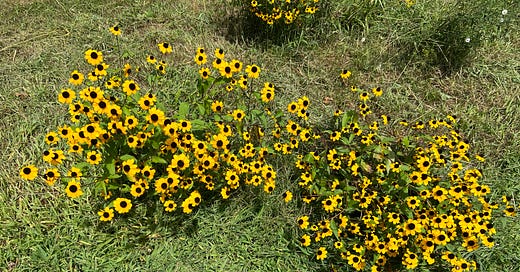The Unknown Danger of Herbicides
Puddock Hill Journal #52: Herbicides, pesticides and fungicides often appear to be the easiest solutions, but their negative consequences may hide in the ground.
Before I get into this week’s newsletter, please lend me a minute of your time.
As many readers know, in addition to tending to Puddock Hill and writing about it, I primarily write fiction these days.
Published last month, my latest novel, We Once Were Giants, served as the Capstone to my 2022 master of environmental studies (MES) degree from the University of Pennsylvania. As page-turning speculative fiction, it’s both entertainment and a warning.
Fellow Substacker Paul Hormick wrote a rave review in The Green Dispatch.
Although it’s early days and reader reviews are sparse, Amazon readers have given the novel a superlative five stars, and it has 4.67 stars from the notoriously picky readers of GoodReads, one of whom wrote:
Fishman's writing transports you into a future where climate change and pollution have continued unchecked, to their inevitable conclusion. But this isn't just about climate change, it's about people and the types of societies we can build. I was so engaged with the characters and their stories that it wasn't until I was more than half-way through that it struck home that this isn't just a story, it's a warning. This book does this without ever reading like a lecture. Highly recommend.
A few weeks ago, I began serializing the book here on Substack, where you get three pieces a week plus my commentary. The bulk of the novel will soon go behind a paywall, where it (and bonus material) will cost you fifty bucks for the year (essentially the Substack minimum). Most readers would probably prefer to pick it up cheaper and faster from Amazon as a Kindle ebook or in paperback. If you enjoy reading fiction, please buy a copy of We Once Were Giants today and spread the word! I would be most grateful.
Now on to our regular programming…
My recent newsletter about the war on Japanese stiltgrass garnered more feedback than most. Some of it was commiseration. Yeah, right back atcha! A couple of people suggested that they’ve been having some success with herbicides, both topical and pre-emergent. The former interrupts a plant’s system after entering through leaf pores; the latter prevents seeds from germinating.
These methods have the benefit of being easier than the physical removal and disruption which I advocate, and I certainly can understand the impulse to spray, especially given my ongoing frustration fighting invasives with string trimmer and mower and clipper and lopper. Lord knows, there are times when I’d like to call in a nuclear strike.
But there’s a problem with using herbicides or any chemical products in the environment, and those problems can be summed up in two words: unintended consequences. When we apply an herbicide and it works, we take great satisfaction in the visual evidence before us in the form of a dead weed or invasive plant. But what has that chemical done in places that we can’t see?
Out of sight may be out of mind, but it’s not out of the environment. Think of what invisible carbon dioxide and methane are doing to our climate. Or the microplastics that now pollute rainfall in the Pacific Northwest. Or “forever chemical” PFOAs that permeate all of modern existence. We don’t see these things, but we are coming to know that they can harm human life and life all around us.
We like to fool ourselves into thinking the latest thing is always better. Just a generation ago, we thought DDT would improve lives, but Rachel Carson called our attention to the devastation it wrought on wildlife. Then it was the miracle weed-killer Roundup, which was said to be completely safe until associations with nervous system damage and, possibly, cancer were found.
A word about Roundup. The EPA deems its active ingredient to be safe, but here’s a little secret: EPA requires testing of active ingredients but not the whole formulation of a product, and that formulation is usually proprietary. Independent scientists do not know the exact formula for Roundup, which, like similar products, contains surfactants and adjuvants intended to make it more effective, and possibly other chemicals to render it shelf stable. Perhaps the active ingredient (glyphosate) is safe but the product as a whole is less safe. We don’t really know, and—as with so many chemicals we’ve unleashed on the environment only to learn of their harms later—it may take a lifetime to find out.
Many herbicides are said to break down after use over a short period of time, but what does it mean to break down? Do their molecules evaporate into harmless individual atoms or do they get consumed in the ground by living organisms such as bacteria and fungus? If the latter, how do these chemicals affect these organisms along the way? How does that impact the natural balance?
Anyone who tells you they have definitive answers to these questions is being naive or disingenuous. And these questions matter a great deal for our health and the sustainability of our environment.
Ashes to ashes, dust to dust. Everything we are, everything we do comes from the soil.
This fact was driven home recently for me by several studies that crossed my feed in the past couple months.
Keep reading with a 7-day free trial
Subscribe to Backyard Stewardship to keep reading this post and get 7 days of free access to the full post archives.


